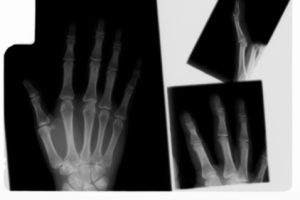 You might think a broken finger is a minor injury, but without proper treatment it can cause major problems. The bones in a normal hand line up precisely, letting you perform many specialized functions like grasping a pen or manipulating small objects in your palm. When you fracture a finger bone, it can put your whole hand out of alignment. Without treatment, your broken finger might stay stiff and painful.
You might think a broken finger is a minor injury, but without proper treatment it can cause major problems. The bones in a normal hand line up precisely, letting you perform many specialized functions like grasping a pen or manipulating small objects in your palm. When you fracture a finger bone, it can put your whole hand out of alignment. Without treatment, your broken finger might stay stiff and painful.
Signs of a fractured finger
- Swelling.
- Tenderness.
- Inability to move it completely.
- Deformity.
Diagnosis
If you think you broke your finger, tell your doctor right away exactly what happened and when. You have three bones (phalanges) in each finger and two in each thumb. Your doctor must determine not only which bone fractured, but also how it broke: straight across, in a spiral, into several pieces, or shattered completely. Your doctor may want to see how your fingers line up when you extend your hand or make a fist. Does any finger overlap its neighbor? Angle in the wrong direction? Look too short? Your doctor may X-ray both of your hands for comparison.
Treatment and rehabilitation
Your doctor will put your broken bone back into place, usually without surgery. Sometimes you need pins, screws or wire to hold it together, especially if you have a complicated injury. You'll get a splint or cast to hold your finger straight and protect it from further injury while it heals. Sometimes your doctor may splint the fingers next to the fractured one for support. Your doctor will tell you how long to wear the splint—usually about 3 weeks. Sometimes you may need more X-rays as you heal so your doctor can check your progress.
Begin using your hand again as soon as your doctor determines it is okay to move your finger. Doing simple rehabilitation exercises each day will help reduce the finger's stiffness and swelling. You may be required to see a physical therapist to assist you in these exercises.
Source: Midwest Orthopaedics at Rush www.rushortho.com





